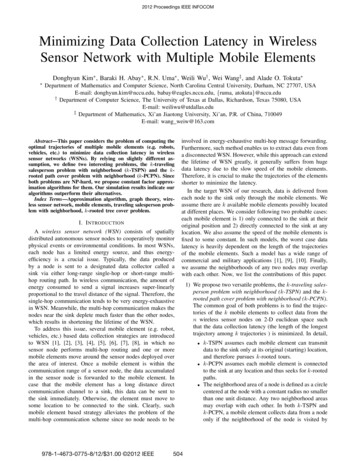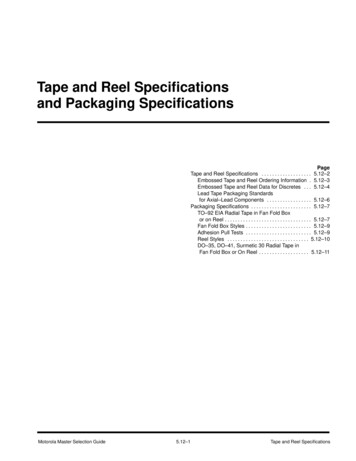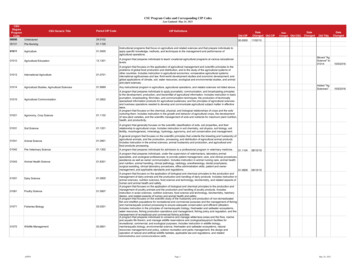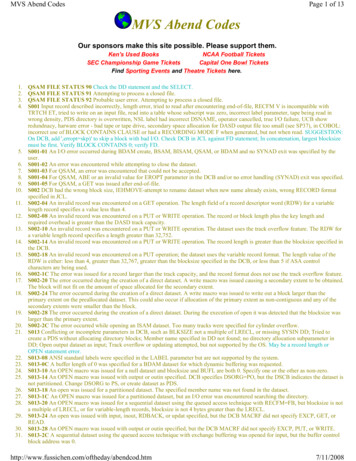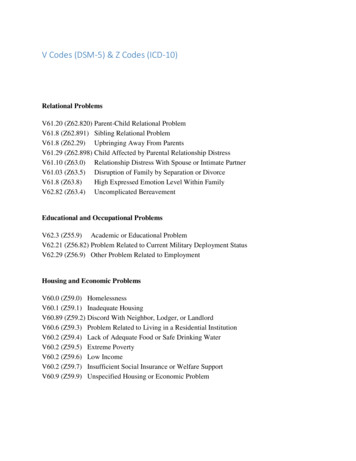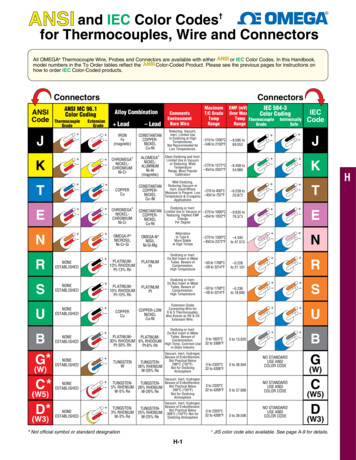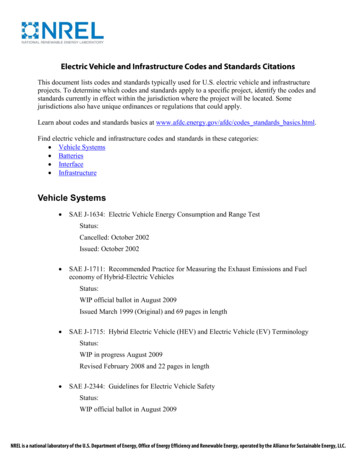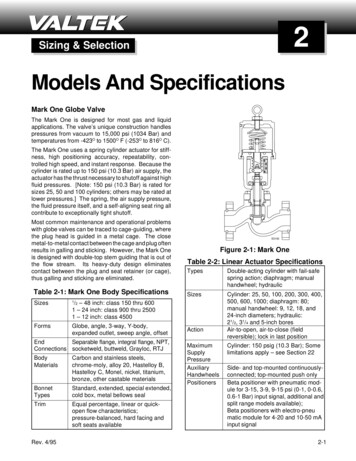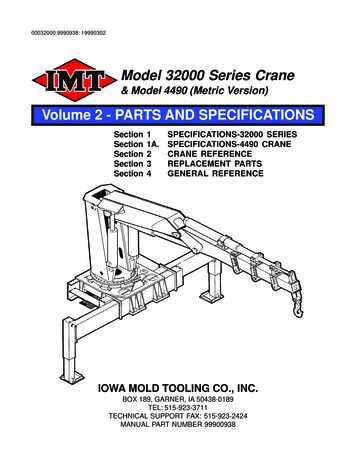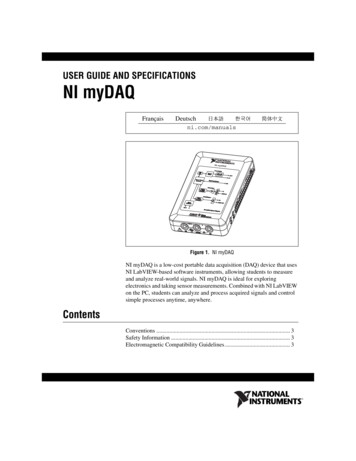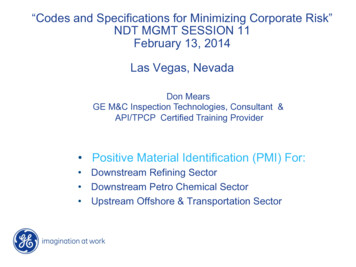
Transcription
“Codes and Specifications for Minimizing Corporate Risk”NDT MGMT SESSION 11February 13, 2014Las Vegas, NevadaDon MearsGE M&C Inspection Technologies, Consultant &API/TPCP Certified Training Provider Positive Material Identification (PMI) For: Downstream Refining Sector Downstream Petro Chemical Sector Upstream Offshore & Transportation Sector
Presenter: Don MearsPresident of Analytical Training ConsultantsOil & Gas Industry Consultant for GE Oil & Gas-InspectionTechnologiesAuthor of API RP 578 2nd Edition PMI Certification CourseCertified API Training Provider Certification TPCP# 011830 Years in the Oil & Gas IndustryAPI Member and Sub-Committee Member on API TechnologyAPI/TPCP- ‐01182GE O&G Consultant, Don Mears2/14/14
Presentation Outline: Introduction- Why Implement PMI According to API RP 578Downstream Sector-Refining-OSHA NEPDownstream Sector-Petrochemical-OSHA CHEMNEPUpstream Sector- Off Shore & Transportation-BSEE, DOT/PHMSA,NTSB API RP 578 –Testing Suggestions-Explained–––––New Construction- QA/MVP ProgramsExisting Piping Systems ( Retro-Active PMI ) ProgramsControl of Incoming Materials & WarehouseElements of Maintenance Systems for PMIRecording & Reporting PMI Test Results API 578 PMI Certification Course Advantage Conclusion (Questions and Answers)3GE Title or job number2/14/14
Introduction: “Why should you implement PMI according toAPI 578 ?” Note: The leading insurance industry statistics indicating that the US refining sector has more than threetimes the rate of property losses of refineries overseas. Dr. Moure-Eraso with USA Chemical Safety Board (CSB) urgescompanies to take action to prevent accidents, including:– Implement a robust “mechanical integrity” programs withan emphasis on thorough inspections of critical equipment– Monitor process safety performance using appropriateleading and lagging indicators to measure process safety“before major accidents” occur– Maintain an open and trusting safety culture where nearmisses and loss of containment incidents are reported andinvestigatedAerial view of the damaged heatexchangers following the April 2,2010 fireClose-up of ruptured heat exchanger4GE O&G Consultant, Don Mears2/14/14
Introduction: “Corrosion Failures in ProcessPiping” 41% of the largest losses in the hydrocarbon processing industry resulted fromfailures in piping systems . Corrosion is one of the leading causes of piping failures. OSHA’s National Emphasis Program (NEP) includes positive material identification(PMI) as a part of Mechanical Integrity (MI) “Recognized And Generally Accepted Good Engineering Practices” or “RAGAGEP”– Example RAGAGEP for PMI: API RP 578, Material Verification Program for New and ExistingAlloy Piping Systems, Section 4.3 CSB, Safety Bulletin – Positive Material Verification: Prevent ErrorsDuring Alloy Steel Systems Maintenance, BP Texas City, TXRefinery Fire Second International Symposium on the Mechanical Integrity of Process PipingJanuary 1996, Houston, TX, USA5GE Title or job number2/14/14
Why OSHA Establish the NEP Program in USA?Occupational Safety and Health Administration (OSHA)Acts Process Safety Management (PSM) 1910-119-Highly Hazardous Chemicals (HHC) 2/24/1992Refinery National Emphasis Program (NEP) CPL 03-00-004 6/7/2007Chemical National Emphasis Program (NEP) 09-06 (CPL 02) Notice – Pilot NEP 7/27/2009Chemical National Emphasis Program ( CHEMNEP) (CPL 03-00-014)-Nationwide 11/29/2011American Petroleum Institute (API) Standard-API-570-Piping Inspection CodeStandard-API-510-Pressure Vessel Inspection CodeStandard-API-653-Storage Tank Inspection CodeRecommended Practice-API RP-578-Material Verification Program-MVP/PMIRecommended Practice-API 571 – HF Corrosion in CS Pipes ( REs, Cr, Cu, Ni )Recommended Practice-API 939-C-Guidelines for Avoiding SulfidationMechanical Integrity Needs in the Oil & Gas Industry Understanding HOW, WHY, & APPLYING:ü ATC – API 578 PMI Certification Training Courseü AIM- Asset Integrity Managementü MI- Mechanical Integrity Requires, “ Data Management” Software6GE Title or job number2/14/14
“Codes and Specifications forMinimizing Corporate Risk”Handheld X-ray Fluorescence for PMI &OSHA’s (NEP)-”National EmphasisProgram”Downstream Refining SectorDon MearsOil & Gas Industry Consultant
Why Did OSHA Establish the NEP Program in USA ? According to OSHA’S refinery database: 36 fatality/catastrophe (FAT/CAT) incidents Related to HHC since May 1992 52 employee deaths Includes 250 employee injuries, 98 with hospitalization # of incidents surpass the combined total of the next 3 highestindustries Chemical Manufacturing-12 FAT/CAT Industrial Organic Chemical Manufaturing-12 FAT/CAT Explosive Manufacturing-11 FAT/CAT8GE Title or job number2/14/14
Hazards Identified: TotalViolations Rise; Serious andRepeat Violations IncreaseOSHA Violation StatisticsFY2003FY2004FY2005FY2006FY2007% Change2003-2007Total Violations83,53986,70885,30783,91388,8466.4%Total Serious 81919,24618,331Total Willful ViolationsTotal Repeat ViolationsTotal Other-than-Serious2.726.4%-10.8%BP Texas City, Texas:Fined 30.7 millionfor 439 willful violationson 10/30/09-Resolved 409citations in July 2012 and paid 13 million by end of year !9GE Title or job number2/14/14
Refinery NEP Enforcement Summery from 2007-20012 Comprehensive-(151 Refineries in USA) Average 1,000 OSHA hours per inspection Typically use full statutory 6 months available Also resource intensive for employers Compliance found to be highly uneven Substantial issues identified Average penalties/inspection 166,000 Average penalty/violation 9,560 Average violations/inspection 17.410GE O&G Consultant, Don Mears2/14/14
Refinery NEP Most Frequently Cited PSMElementsElementDescription% ofCitationsCumulative%jMechanical Integrity19.4%19.4%dProcess Safety Information17.5%36.9%fOperating Procedures17.1%53.9%eProcess Hazard Analysis17.0%70.9%lManagement of Change8.2%79.1%mIncident Investigation6.7%85.8%oCompliance 5.2%nEmergency Planning & Response1.5%96.7%cEmployee Participation1.4%98.1%iPre-startup Review1.1%99.2%kHot Work Permit0.8%100.0%
OSHA’S Reasons Why – RAGAGEP“Recognized And Generally Accepted Good EngineeringPractice” (RAGAGEP):Engineering, operation, or maintenance activities based onestablished codes, standards, published technical reports orrecommended practices (RP) or a similar document.RAGAGEPs detail generally approved ways to performspecific engineering, inspection or mechanical integrityactivities, such as fabricating a vessel, inspecting a storagetank, or servicing a relief valve (See CCPS [Ref. 33]).12GE Title or job number2/14/14
Inspection Scheduling by OSHA’s NEP –All Refineries Section E-10-Question on PMIPositive Material Identification (PMI)Does the employer ensure that replacement piping is suitablefor its process application? Yes, No, N/AIf no, possible violations include: The employer did not follow RAGAGEP when it failed toconduct positive material identification (PMI) testing. Example RAGAGEP for PMI:– API RP 578, Material Verification Program for New andExisting Alloy Piping Systems, Section 4.3)– CSB, Safety Bulletin – Positive Material Verification:Prevent Errors During Alloy Steel Systems Maintenance,BP Texas City, TX Refinery Fire13GE Title or job number2/14/14
“Codes and Specifications forMinimizing Corporate Risk”Handheld X-ray Fluorescence for PMI &OSHA’s CHEM NEPDownstream Petro Chemical SectorDon MearsOil & Gas Industry Consultant
Chemical Safety Board (CSB)Established in1990After the deadly 1989 explosion of PhillipsHouston Chemical Complex that claimedthe lives of 23 people in Pasadena,Congress setup a system designed to reducethe number of chemical accidents by formingthe investigative board, known for short asCSB. Congress established the board tooverhaul the Clean Air Act and to create anindependent agency designed to keep tabson the chemical and petroleum industry.According to the findings of the U.S. ChemicalSafety and Hazard Investigation Board, since1998 an average of five plant workers havebeen killed every month in the UnitedStates by explosions or leaks of chemicalsthat have become integral to modernindustrial life.15GE Title or job number2/14/14
CSB Releases Case Study on Fatal 2008 Accident at Goodyear Tire andRubber Plant in Houston, TexasThe accident occurred on June 11, 2008, when an “Recognized And Generally Acceptedoverpressure in a heat exchangerGood EngineeringCSB identifies gaps in facility emergency response Practice” (RAGAGEP):training and calls for increased adherence toIs what OSHA/CSB require from ourexisting industry codes.CSB Investigations Supervisor Robert Hall said, “Wefound the accident likely would not havehappened had operators followed the ASMEcode”Petro Chemical Companies !!!!CSB investigations look into all aspects of chemicalaccidents, including physical causes such asequipment failure as well as inadequacies inregulations, industry standards, and safetymanagement systems.16GE Title or job number2/14/14
XRF Analyzers in Downstream Process-Petro Chemical PlantsPhillips Petroleum Company’s chemical plant in Houston in 1999-OSHA said thatfailure to train workers properly was a key factor in the explosion and firePesticide Chemical Runaway Reaction Pressure Vessel Explosion (Two Killed, EightInjured) Bayer Crop Science, facility in Institute, West Virginia , August 28,2008CSB Conducting Assessment of Ammonia Release at Millard Refrigerated ServicesSouth of Mobile, Alabama, August 27,2010CSB Chairperson Rafael Moure-Eraso said, "We are seeing too many ammoniareleases in our daily incident reviews. Based on the CSB's monitoring of media reportsthere were four high consequence incidents involving the release of anhydrousammonia which led to a total of six fatalities in 2009: May 14, 2009: American Cold Storage, Louisville, KY 2 fatalitiesJune 20, 2009: Mountaire Farms, Lumber Bridge, NC 1 fatalityJuly 15, 2009: Tanner Industries, Swansea, SC 1 fatalityNovember 16, 2009: CF Industries, Rosemount, MN 2 fatalitiesTherefore; OSHA Released :Chemical National Emphasis Program ( CHEMNEP)(CPL 03-00-014)-Nationwide 11/29/201117GE O&G Consultant, Don Mears2/14/14
Chemical Plant NEP Inspections for Pilate Program inRegions (1,7,10) As of August, 2010, 112 inspections opened 38 Un-programmed (34%) 74 Programmed (66%) 9 resulted in no inspection occurring because there was no PSM coveredprocess 62 inspections have issued citations Average 9.0 citations per inspection Average 3,500 per citation Over 60 different standards cited 44% of all citations were other than PSM Therefore: OSHA Released :Chemical National Emphasis Program(CHEMNEP) (CPL 03-00-014)-Nationwide 11/29/2011
Chemical Plant NEP Citations by PSM 0%mIncidentInves1ga1on2.6%97.6%iPre- ‐startupReview1.4%99.0%kHotWork1.0%100.0%
“Codes and Specifications forMinimizing Corporate Risk”Handheld X-ray Fluorescence for PMI &BSEE,PHMSA, & NTSBUpstream Offshore & TransportationSectorDon MearsOil & Gas Industry Consultant
The Bureau of Ocean Energy Management, Regulation and Enforcement (BOEMER)Changed to (BSEE)Also on October 1, 2011, the new Bureau of Safety and Environmental Enforcement (BSEE)was created to enforce safety and environmental regulations. Functions include: All fieldoperations including Permitting and Research, Inspections, Offshore Regulatory Programs,Oil Spill Response, and newly formed Training and Environmental Compliance functionsWWW.BSEE.GOV21GE O&G Consultant, Don Mears2/14/14
PMI Inspection Program for Deep Water Sub-Sea Equipment –Important Before Installation Confirm with PMI that your material isin specification before Fabrication. Confirm all supply parts (valves,flanges, pipes, welds, etc.) are what isspecified for application.22GE Title or job number2/14/14
Pipeline and Hazardous Material Safety Administration23GE Title or job number2/14/14
PHMSA issued Advisory Bulletin 09-01 on May 21, 2009This bulletin advises pipeline operators of material problems – inconsistent chemical( PSL 2 specifications ) and material properties ( Yield Strengths, & Tensile Strengths) –that have been found in micro alloyed high-strength line pipe grades, generally grade X-70 andabove.Some pipe material did not meet the requirements of the American Petroleum Institute,Specification for Line Pipe—5L, (API 5L), 43rd edition for the specified pipe grade even thoughthe pipe supplier provided documentation that the pipe met these minimum standards.( MTR’S)It suggests that pipeline operators closely review manufacturing specifications for the productionand rolling of steel plate. ( Trust by Verify with PMI )24GE O&G Consultant, Don Mears2/14/14
API 5 L-(45th Edition) for Line PipeCurrently API 5L “Does NOT” stress Confirming the Chemical Analysis forElements with Positive Material Identification (PMI) with either XRF or OES fieldAnalyzers !!!! The Question is Why NOT?:We have already shown you that the “ End User” can no longer rely only on --Material Test Reports ( MTR’s)---OSHA has a “Nation Emphasis Program” (NEP) to Enforce (RAGAGEP ) forthe Market Segments in the Oil & Gas Downstream both Refining & Petro Chemicalfacilities and found that Mechanical Integrity (MI) is the number one Violation( 19.4% to 23.8%) of “Process Safety Management” (PSM)- Process SafetyManagement (PSM) 1910-119-Highly Hazardous Chemicals (HHC).“TrustbutVerify”- ‐Thisiswh
– API RP 578, Material Verification Program for New and Existing Alloy Piping Systems, Section 4.3) – CSB, Safety Bulletin – Positive Material Verification: Prevent Errors During Alloy Steel Systems Maintenance, BP Texas City, TX Refinery Fire . Don Mears Oil & Gas Industry Consultant Handheld X-ray Fluorescence for PMI & OSHA’s CHEM NEP- Downstream Petro Chemical Sector “Codes and .

